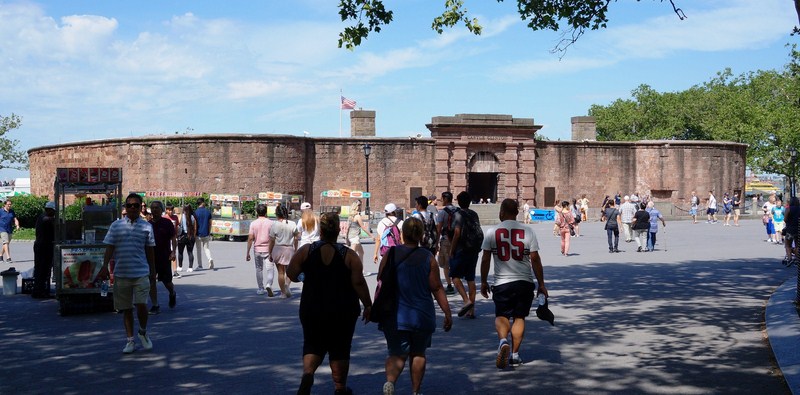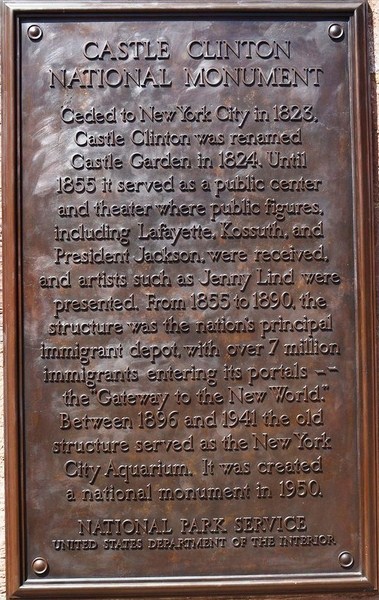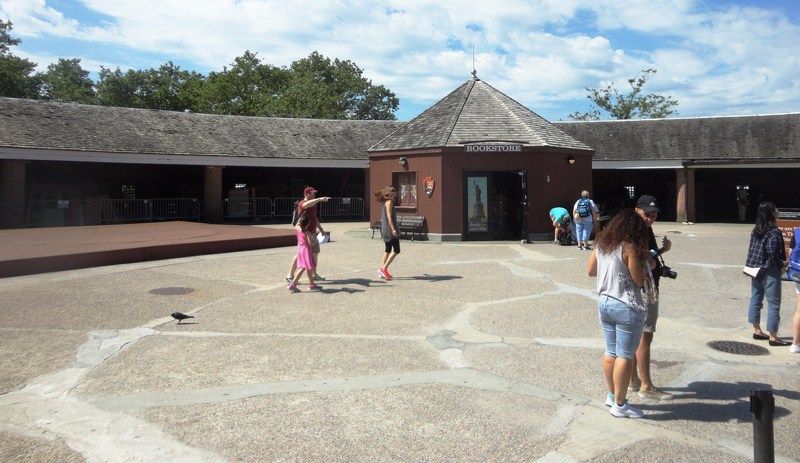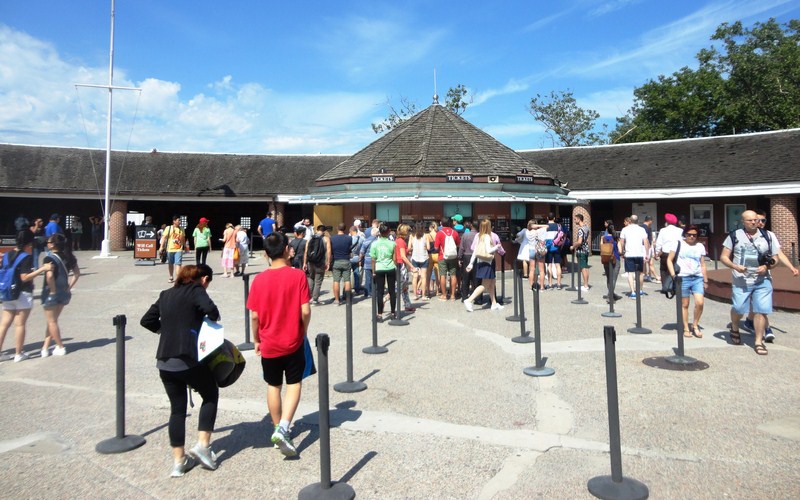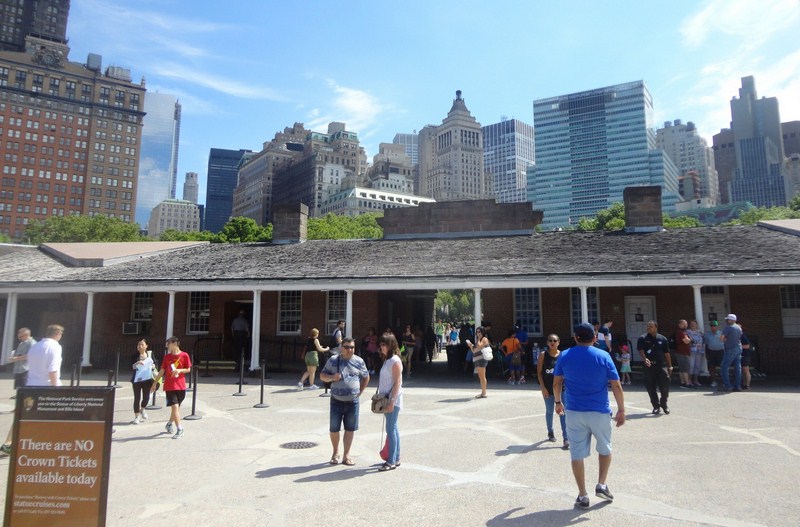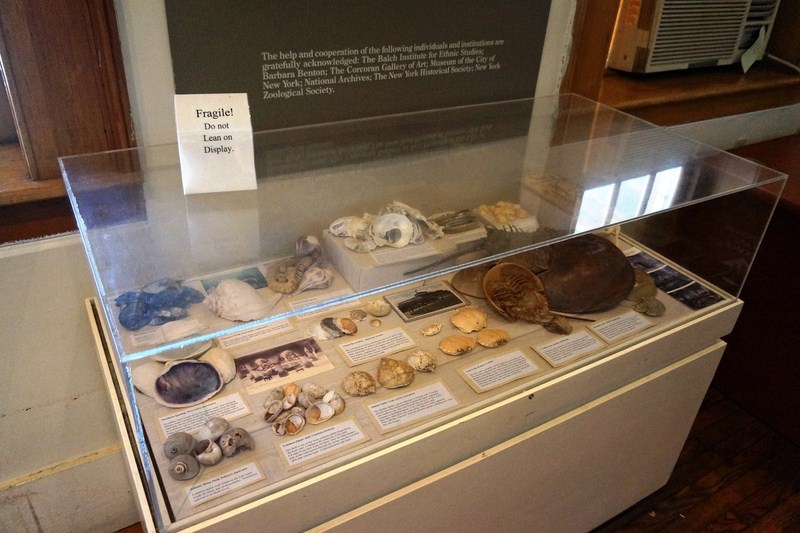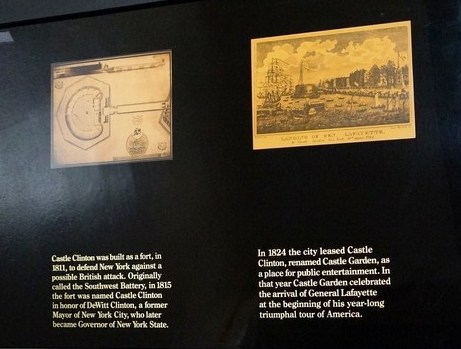The 0.4-hectare (1 acre), Medieval-looking Castle Clinton (or Fort Clinton), a circular sandstone fort previously originally known as West Battery and sometimes as Southwest Battery and Castle Garden, was the first American immigration station (predating Ellis Island), where approximately 7.7 million people arrived in the United States from 1855 to 1890. Lying near the northwestern corner of Battery Park, it serves as the park’s main attraction.
Some of the few noteworthy immigrants who passed through here include:
- Mary Mallon (Typhoid Mary) – the first person in the United States identified as an asymptomatic carrier of a typhoid fever pathogen
- Nikola Tesla – a Serbian-American inventor, electrical engineer, mechanical engineer, and futurist best known for his contributions to the design of the modern alternating current (AC) electricity supply system
- Harry Houdini – Hungarian-born American escape artist, illusionist, stunt performer and mysteriarch, noted for his escape acts.
- Emma Goldman – anarchist political activist and writer who played a pivotal role in the development of anarchist political philosophy in North America and Europe in the first half of the 20th century.
- Joseph Pulitzer – Hungarian-born American newspaper publisher of the St. Louis Post-Dispatch and the New York World.
- Friedrich Trumpf – German–American barber, businessman, and patriarch of the Trump family. He is the grandfather of Donald Trump.
Check out “Ellis Island National Museum of Immigration”
Built from 1808 to 1811, it has, over its active life, functioned as an administrative headquarters, a paymaster’s quarters and storage area for the United States Army (until 1821), a beer garden, exhibition hall, theater, and public aquarium. Castle Clinton stood slightly two blocks west of where Fort Amsterdam was built in 1626 (when New York City was known by the Dutch name New Amsterdam). By 1790, after the American Revolutionary War, Fort Amsterdam was demolished.
Here is the historical timeline of Castle Clinton:
- In 1807, a group of three commissioners, including Lt.-Col. Jonathan Williams (a grandnephew of Benjamin Franklin) of the United States Army Engineers, submitted a report that recommended the construction of fortifications in New York Harbor.
- In 1808, construction of the fort began on a small artificial island just off shore which was connected to Battery Park by a 200-ft. long wood causeway and drawbridge.
- In 1811, the fort was completed although modifications continued through the 1820s.
- In 1817, West battery was renamed Castle Clinton, its current official name, in honor of New York City Mayor De Witt Clinton (who eventually became Governor of New York).
- In March 1822, it was ceded to the city by an act of Congress.
- In June 1824, the fort was leased to New York City as a place of public entertainment.
- On July 3, 1824, it opened as Castle Garden (a name by which it was popularly known for most of its existence), an open-air structure serving, in turn, as a promenade, beer garden/restaurant, exhibition hall (new inventions such as the telegraph, Colt revolving rifles, steam-powered fire engines, and underwater electronic explosives were demonstrated there), opera house and theater.
- That same year, it celebrated the arrival of Gen. Lafayette at the beginning of his year-long triumphal tour of America.
- In 1844, a domed roof was placed to accommodate a 6,000-seat theater.
- In 1850, to initiate her American tour, Swedish soprano Jenny Lind (the “Swedish Nightingale”), brought to America by by P.T. Barnum (famous for his American Museum full of “freaks” and, later, the famous circus which bears his name), gave two concerts for charity at the castle.
- In 1851, European dancing star Lola Montez performed her notorious “tarantula dance” in Castle Garden.
- In 1853–54, Louis-Antoine Jullien, the eccentric French conductor and composer of light music, gave dozens of very successful concerts mixing Classical and light music.
- On June 17, 1851, the Max Maretzek Italian Opera Company notably staged the New York premiere of Gaetano Donizetti‘s Marino Faliero.
- On July 20, 1854, the Max Maretzek Italian Opera Company also staged the New York premiere of Giuseppe Verdi‘s Luisa Miller at Castle Garden.
- During the 1860s, landfill was used to expand Battery Park at which point the island containing the fort was incorporated into the rest of Manhattan Island.
- In the first half of the 19th century, most immigrants arriving in New York City landed at docks on the east side of the tip of Manhattan, around South Street.
- On August 1, 1855, Castle Clinton became the Emigrant Landing Depot, functioning as the New York State immigrant registration center (the nation’s first such entity).
- On April 18, 1890, the S. government assumed control of immigration processing from the state government.
- On January 2, 1892, after many unnecessary deaths and scandals over immigration workers cheating and stealing from immigrants, the immigration control was taken over by the federal government and the immigrant registration center was moved to the larger, more isolated Ellis Island
- On June 15, 1897, a fire consumed the first structures on Ellis Island, destroying most of Castle Clinton’s original immigrant passenger records (it is generally accepted that approximately 7.7 million immigrants and, perhaps, as many as 10 million were processed during its operation).
- On December 10, 1896, Castle Garden was opened as the site of the New York City Aquarium (designed by McKim, Mead & White) which, for many years, was the city’s most popular attraction, drawing hundreds of thousands of visitors each year to see its Beluga whale, sea lions and exotic fish. The structure was extensively altered and roofed over to a height of several stories, though the original masonry fort remained.
- In 1941, Triborough Bridge and Tunnel Authority Commissioner Robert Moses wanted to tear the structure down completely, claiming that this was necessary to build the Brooklyn–Battery Tunnel.
- In September 1941, to expedite construction of the tunnel, the city closed the New York Aquarium and moved its fish to other aquariums. The aquarium was not replaced until Moses opened a new facility on Coney Island in 1957.
- On August 12, 1946, President Harry S. Truman signed the legislation making the castle a U.S. National Monument.
- In July 1947, the New York City Board of Estimate voted to demolish Castle Garden. However, the Board delayed the demolition for another year to allow the federal government to review the decision.
- In May 1948, the Board voted to demolish the castle for the sixth time in as many years.
- After another year of discussion, the New York State Assembly reversed its decision to allow the castle to be demolished.
- On July 18, 1950, the federal government finally obtained the property after the city deeded the land and castle to the federal government.
- In 1956, after funding had been secured, a project to renovate Castle Clinton was announced.
- On October 15, 1966, Castle Clinton National Monument was listed on the National Register of Historic Places.
- In the 1970s, a major rehabilitation took place, largely restoring it to its original appearance.
- In 1975, Castle Clinton was reopened.
Designed by John McComb Jr. and Jonathan Williams, West Battery had a red brick facade, 8-ft. thick walls and was roughly circular in shape, with a radius of approximately 28 m. (92 ft.).
About one-eighth of the circle was left “unfinished,” with a straight wall constructed between the “unfinished” segments.
Intended to complement the three-tiered Castle Williams (the East Battery, on Governors Island, named after Jonathan Williams) with crosshair fire so that the channel between them could be closed, West Battery was armed with 28 cannons, in casemated gun positions, which could fire a 32 pound cannonball a distance of 1.5 miles into the harbor. Although garrisoned in 1812, the fort never saw action in any war.
Currently administered by the National Park Service and now part of the Statue of Liberty National Monument, Castle Clinton is now a departure point for visitors to the Statue of Liberty and Ellis Island, housing an information center and ticket booths for the ferries.
In 2009, it recorded nearly 4.08 million visitors. In addition, the fort contains a small history exhibit and occasionally hosts concerts.
Check out “Statue of Liberty National Monument”
Castle Clinton National Monument: Battery Park, 26 Wall St., Manhattan, New York City 10005. Tel: (212) 344-7220.

